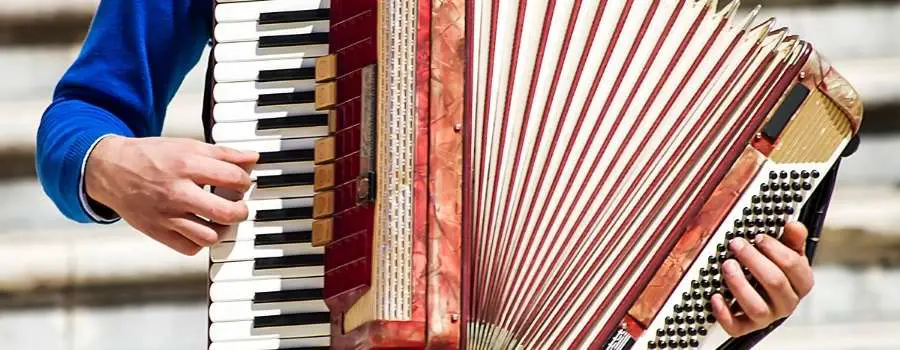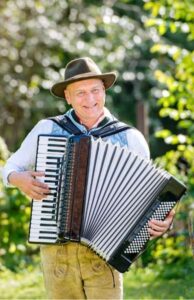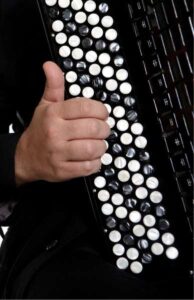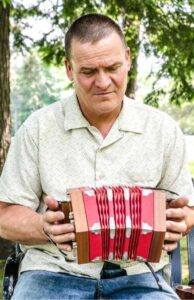
The old squeezebox…accordions used to be the butt of a lot of jokes on classic sitcoms and movies, but there has been a bit of a resurgence in popularity lately largely thanks to some bands incorporating folk instruments into their music. Not all of us are lucky enough to find old musical instruments in grandma’s attic, so what can we expect to pay for a new accordion?
In general, expect to pay between $500 – $600 for a new entry-level accordion. Factors such as the number of keys/buttons, brand, and finishes can make prices fluctuate from a few hundred dollars to several thousand. Some custom-made, professional models can run upwards of $15,000.
It really comes down to what type of accordion you’re looking for…or if you’re even looking for a traditional accordion or a related instrument. Since there are a few factors to look into, I decided to take a look at the most popular instruments in the accordion family:
- Piano Accordions
- Button Accordions
- Concertina
I decided to look at the more readily available “consumer” brands…I figure most people looking up the cost of an accordion aren’t wanting to fork out the cash for a custom-built model.
For information on determining the value of Vintage Accordions, check out this article.
Piano Accordions

This is the instrument most people think of when they hear someone mention an accordion. They are ideal for people who already know how to play the piano since they won’t have to learn the fingering system of a button accordion.
On the downside, they are a bit larger and heavier than button models and don’t have quite the range.
For pricing, I’m going to try to base everything on an entry-level average sized instrument, but know that the following can cause the price to go up or down:
- Type of Wood
- Elaborate Decorations (Brass Work, Inlays, etc.)
- Mutes
- Palm Switch
- Electronics (Volume Controls, MIDI connections, Mic Plugs, etc.)
These three seem to be the most popular models and all are available through online shops however, I’m a big advocate of try before you buy when it comes to purchasing high-cost items such as musical instruments. Hohner has high marks and looks to be the most popular, but that might not be the case for everyone.
| INSTRUMENT | Price (Low Average for Brand) |
| Hohner | $850 |
| Sofiamari | $580 |
| Rossetti | $700 |
Button Accordions

Button accordions are said to be more difficult to learn than piano accordions since the button-fingering mechanism isn’t as intuitive as a keyboard layout. The upside is once learned, players can play faster since the buttons are closer together than keys would be making them more nimble to play.
Button accordions come in two main types:
- Diatonic (Bisoniric)-standard models will have a single row of buttons and will be tuned to a specific scale and play in that scale only. For instance, if tuned to D Major it will play D-E-F#-G-A-B-C# (models are usually built to play 2.5 octaves.)
Bisonoric means that when a button is pushed it will play one note when the bellows are opened and a different note when the bellows are closed. The bass buttons will alternate between tonic and dominant chords when the bellows are opened or closed, respectively.
This type of accordion is mainly used in folk music or tunes that only need basic chords. - Chromatic (Unisonoric)-chromatic models are similar to piano accordions since they can play all the notes of a chromatic scale (C-C#-D-D#-E-F-F#-G-G#-A-A#-B.) They will also be designed to play multiple octaves and will have 3-5 ranks of buttons rather than a single row like diatonic models.
Unisonoric means that the same note will play whether the bellows are being opened or closed.
Jazz musicians and concert performers prefer chromatic models since they will be playing music in all sorts of keys and may even need to transpose on the fly, something that’s impossible on a diatonic model.
It’s a little difficult to settle on a style or size of button accordion when putting together a general price list. There are various sizes and button configurations that make the price fluctuate greatly…so this chart is focussing on the less expensive models for each brand.
| INSTRUMENT | Price (Low Average for Brand) |
| Hohner (Diatonic) | $600 |
| Alacran (Diatonic) | $650 |
| M.Gerarda (Chromatic) | $1800 |
| Hohner (Chromatic) | $5000 |
Concertina

The concertina is a smaller instrument in the accordion “free reed” family. It more closely resembles button-style accordions since it also uses rows of buttons to change pitch. It can also be made unisonoric or bisonoric just like button accordions.
Where it differs is in it’s signature hexagonal shape and that the buttons are on the sides rather than forward facing.
Accordions have been a tricky instrument to research since there are so many sizes and variations on them and the concertina is no different mainly because two instruments that would become the concertina were developed simultaneously in England and Germany in the early 1800s.
As a result the world now has no less than 3 main types of concertina’s:
- English and Duet – Typically chromatic and unisonoric with a key layout that alternates from left to right hand.
- German – A little larger than English models, German concertinas are bisonoric and usually have multiple reeds per note to create sympathetic buzzing (vibrato effect.)
- Anglo – English instrument makers liked and developed a concertina that uses German fingerings but is designed to work better with traditional English folk music.
All are similar in sound but different in button layout, meaning a player couldn’t pick up a German model and play it if he only knew how to play an English concertina.
| INSTRUMENT | Price (Low Average for Brand) |
| Hohner (German) | $250 |
| Musicians Gear (Anglo) | $260 |
| Wren (Anglo) | $500 |
| Sparrow (English) | $600 |
Final Thoughts
This article is by no means meant to be a price guide or recommendations list. I’ve been wanting to pick up a concertina to learn how to play and use in some film scores I’m working on and that led me down a giant rabbit hole I never knew existed.
Bottom line, if you’re wanting to pick up an accordion then some research is going to be required for sure! I have several other articles about various aspects of accordions, including one on some basics you may want to check out.
You need to know what you’re looking for before you even worry about a price point. So, think about and research the following:
- What Type of Music Do You Want to Play
- Accordion or Concertina
- Piano Style or Button Style
- Chromatic or Diatonic
- Bisonoric or Unisonoric
After you decide on those things then start looking into brands and pricing. Happy Playing!
